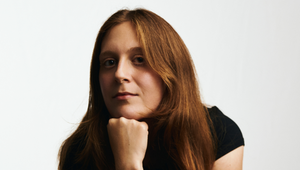
Camera Obscura: Nerding Out Over Cool Lines with Steven Lee

Steven is an LA photographer and CG artist, with a background in illustration and concept design. His work centres around diversity, and aims to unveil reality through the surreal.
LBB> What is your niche craft obsession?
Steven> I’m obsessed with taking artful screenshots of my graph editor when animating in Maya. The graph editor is a graphical representation of the animation in your CGI scene, demonstrated by curves and keyframes, and each curve represents a different axis or control of an object, like its translation through y-space over time, or how much it rotates in the x-axis.
LBB> Where/ when/ how did you first come across this thing?
Steven> As I grew more involved with CGI animation during my first year at motion design studio Frame48, I began to notice how 'accidentally' beautiful the curves in the graph editor were. Sometimes it was a satisfying, perfectly clean and organised animation, while other times, a chaotic, organic mocap (motion capture). Either way, I made it a habit of slacking my co-workers screenshots of my graph editor, nerding out over the cool lines, patterns and shapes it creates. Something that was supposed to be mathematical, objective, data-like information was presenting itself as an expressive composition, and I found my hands constantly hovering over my keyboard, waiting to press Win + Shift + S (the screenshot hotkey) at the sight of a gorgeous graph editor moment. I think in some way, my background as a photographer has informed my sensitivity to capturing and composing these 'candid moments' that happen on my screen, as if they were events happening in real life.


LBB> Was it an obsession straight away or something that has evolved over the years?
Steven> As I accumulated screenshots in my 'GRAPH EDITOR' folder, it very quickly became a mission for me to collect as many screenshots as possible, even asking the whole studio to take screenshots of their graph editors, and send them my way to collect. Since not everyone was an animator, it evolved into screenshotting other tangential, accidental moments that spontaneously happen across the software's we use, like when a program glitches and the window leaves a trail behind when you move it around, when a node network becomes so complex and dense it feels like abstract art, or when testing a character rig starts to look like a demented creature straight from Hell.

LBB> What are the most interesting debates or conversations you are having around this obsession?
Steven> Not to make it deeper than it needs to be, but subconsciously, screenshotting the random, interesting things I’ve come across, including the accidents, surprises, and glitches that pop up in our work is, in a way, constructing a mini museum of the everyday successes and failures. It sort of lightens the impact of a mistake by seeing it as an art form, and by screenshotting it, it’s almost memorialised, and I’m able to leave it behind and try again. It also lets me feel proud of the cool things I’ve made behind the scenes, before the finished product.
A game I like to play with myself is looking at my past graph editor screenshots and trying to figure out what animation it was just by looking at the curves, similarly to the way a vocalist is able to sight-read notes on sheet music. While the graph editor isn’t able to reveal everything about an animation (ex. the translate, rotate, scale will share the same colour on the same axis, you may not know where the motion is pivoting from, the object shape is unknown…etc), it’s still a fun way to test my knowledge and understanding of animation curves.
I’ve also thought about making a little booklet of our screenshots, and naming it something alternative to Frame48, like Frame0 or Frame49 - something adjacent to a 'finsta,' but for a studio. It would just be a very interesting and artful way to capture an inside joke, and to also show what goes behind a polished project.


LBB> How widespread do you think this obsession is with your peers?
Steven> I have yet to see an Instagram account that’s only filled with graph editor screenshots, so I’m determined to be the first. I know a lot of CG animators would appreciate it and feel seen, since the graph editor is where most animators spend the majority of their time, so hopefully I can gather an audience and build a niche community around it.
LBB> Can you share any examples of work where that obsession really came to the fore and elevated the final production? Can you tell us about it and share links if possible?
Steven> In the helmet shots we did for Lazer, the layers of the foam structure go through a sequence of different motions: lifting up, half of them leaving the frame, then collapsing upwards and being taken up by the helmet base. Because the movements were so systematic, moving in one axis at a time, I knew the graph editor would be a pretty clear representation of what’s happening in the Maya viewport. Most importantly, seeing the way the green and blue curves cascade and offset so evenly and smoothly is what tells me that the movement will show me a perfect delayed wave. I love the way you can see the blue keyframes, (representing the foam pieces that are leaving the frame), start as a flat curve, just as the green lines (representing the initial upwards motion) also flatten out and calm down, creating a seamless transition between two sections, as a opposed to any jerky, sudden movements.

In contrast to a clean, motion graphics animation, one of my favourite shots for Muse’s Halloween music video had a more organic approach. I handled and organised mocap for multiple characters running around in a twisty, haunted hallway, and it featured one of my favourite features of the Maya graph editor, which is being able to switch between multiple views of the same animation curves. The two graph editor screenshots above are the same curves, except the first image is a combined view, which helps to compare the magnitude of separate object’s animations in relation to one another, while the second image is a separated view, which helps to compare their timing. In this case, the mocap data was so dense, it wasn’t helpful to look at the combined view, especially because I was not tweaking their animations, but instead, I was using the second image to offset their animations according to their appearance in frame. Nevertheless, both make incredibly interesting screenshots.

Looking back at some of my favourite screenshots now, I have no way of tracing them back to which animation it really was, but I think the mystery is part of the fun and beauty of it.
LBB> For anyone just getting into your field, what advice would you share to help them get their head around this particular thing?
Steven> When I was first animating at Frame48, our ECD, Tom Teller, peering over my shoulder and inspecting my animation curves, would always ask me this question (which has since then become a joke): “Would you ski on those slopes?”, referring to making sure the curves were as smooth and seamless as possible. Although I’ve never been skiing in my life and probably never will (Sorry, Tom), that question built the foundation for my motion graphics animation skills. Instead of constantly staring at my animation and wondering why it doesn’t feel smooth or satisfying, I learned to pay close attention to the nitty gritty details of curve shapes, and eventually was able to animate by just working in the graph editor about 95% of the time.
There are a handful of other ways to improve mograph animation skills, such as studying and collecting references of other CGI spots and constantly asking for feedback. However, I think it’s more important to allow yourself to embrace experimenting and messing around in the graph editor. There are moments before I even start animating, and I’ve planned out a polished idea in my head, I’ll be thinking, “This is going to be a gorgeous screenshot,” and other times, I’ve jumbled up mocap data or dragged a bezier handle farther than normal. These little pockets of time make the best learning moments, and of course, the best screenshots.

















